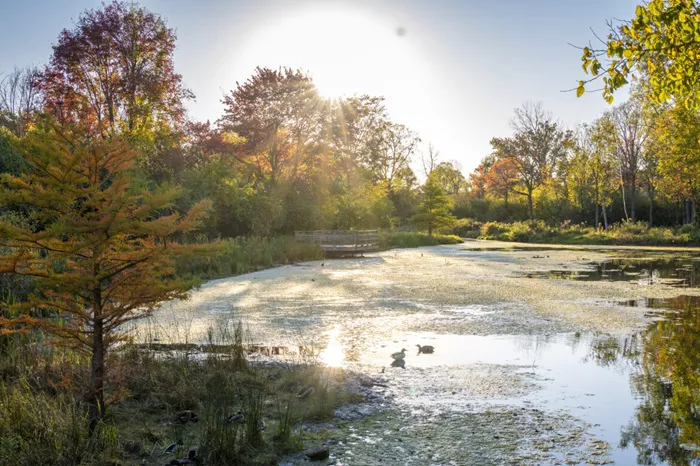EAST LANSING, Mich. — The city of East Lansing is actively addressing the issue of invasive plant species that threaten local ecosystems. The Parks, Recreation and Arts Department is leading efforts to remove these plants and prevent their spread.
Invasive species are non-native plants that are often introduced from other countries. Without natural predators or diseases to control them, these species can proliferate and outcompete native plants, disrupting the natural ecosystem.
Stephanie Day, the invasive species coordinator for the Mid-Michigan Cooperative Invasive Species Management Area, oversees management efforts in Ingham, Eaton, Ionia, and Clinton counties.
“There are various pathways for the spread of invasive species,” Day explained. “Humans often contribute to their spread, but wildlife can also play a role.”
Day provided an example involving the invasive Amur honeysuckle. “People plant it as an ornamental shrub in their yards, but birds eat its berries. These birds can carry the seeds to new locations, allowing the honeysuckle to grow in places where it shouldn’t.”
Cathy DeShambo, director of Parks, Recreation and Arts in East Lansing, oversees the city’s 31 parks and additional trails. She explained that the city is addressing invasive species through its five-year Community Parks and Recreation Plan, which runs from 2025 to 2029.
This plan will enable the city to secure significant grant funding from the Michigan Department of Natural Resources. The city is currently developing the plan with input from the community through online surveys and public meetings.
“This plan will help us enhance outreach and secure funding for managing invasive species while promoting native plants and landscaping in the city,” DeShambo stated.
Last year, the city applied for a large grant to assist with invasive species removal but was unsuccessful. DeShambo noted that competition for grant funding in this area is intense, highlighting the high demand across communities.
The city’s current initiatives to manage invasive species are led by the Environmental Stewardship Program within the Parks, Recreation and Arts Department.
“We have integrated stewardship into our strategic priorities,” DeShambo said. “Our program is unique because many communities lack this level of volunteer participation, which makes it special.”
Heather Majano, the program coordinator, has been working on invasive species management for over a decade. She oversees volunteers, identifies areas in need of work, and educates community members about the issue.
“We have a dedicated group of community volunteers,” Majano said. “They include professors, office workers eager to spend their weekends outdoors, and families of all ages and abilities.”
Majano highlighted the diversity of volunteers who contribute to the program. “It’s inspiring to see our community come together in nature,” she said.
While progress has been made, invasive plants can regrow for up to ten years after removal, even with ongoing monitoring. “Although we are a small program, we have achieved good success in restoring some parks,” Majano noted.
She cited Harrison Meadows Park and Albert A. White Memorial Park as examples of nearly full restoration of native wildlife, thanks to volunteer efforts over the years.
The Environmental Stewardship Program has been incorporated into the five-year plan due to its extensive outreach and effectiveness within the community.
“Our volunteers learn about invasive species and how to manage them,” DeShambo explained. “From a sustainability standpoint, this program impacts many people, creating a ripple effect as volunteers apply what they learn in their own gardens.”
Related topics:


